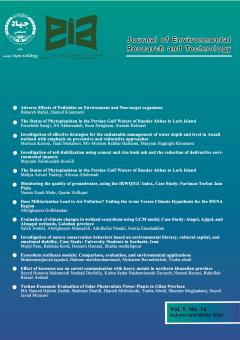Investigation of soil stabilization using cement and rice husk ash and the reduction of destructive environmental impacts
Subject Areas : اقتصاد محیط زیست
1 - Assistant Professor, Department of Civil Engineering, Faculty of Engineering, University of Guilan, Iran
Keywords: Stabilization, Improvement, Pozzolan, Rice Husk Ash,
Abstract :
Given the necessity of using renewable and environmentally friendly materials, this study provides a comprehensive investigation into rice husk ash (RHA) as a sustainable substitute for cement. RHA was selected due to its unique properties, including high pozzolanic activity, abundant availability, easy accessibility in the region, low production cost, and environmental advantages. In this study, following a review of the history and principles of soil stabilization, the production and curing process of RHA at controlled temperatures was examined. The chemical and morphological characteristics of RHA were assessed using advanced laboratory techniques such as X-ray diffraction (XRD) and scanning electron microscopy (SEM). The findings indicate that replacing 20% to 30% of cement with RHA results in achieving compressive strengths approximately 90% to 95% that of control samples. Moreover, using RHA as a natural pozzolan not only enhances the geotechnical properties of soil—such as increasing shear strength and reducing swelling potential—but also leads to a 40% to 45% reduction in cement consumption. This, in turn, results in an approximate reduction of 0.5 tons of CO₂ emissions per ton of replaced cement. From an environmental standpoint, the application of RHA not only addresses the issue of agricultural waste disposal but also constitutes an effective step toward sustainable development and the preservation of natural resources.
Nair, D. G., Fraaij, A., Klaassen, A. A., & Kentgens, A. P. (2008). A structural investigation relating to the pozzolanic activity of rice husk ashes. Cement and concrete research, 38(6), 861-869.
Ghorbani, A., & Salimzadehshooiili, M. (2019). Dynamic characterization of sand stabilized with cement and RHA and reinforced with polypropylene fiber. Journal of Materials in Civil Engineering, 31(7), 04019095.
Salimzadehshooiili, M. (2023). Investigation of the effect of frequency on shear strength and damping of pure sand and sand stabilised with rice husk ash using cyclic triaxial tests. Advances in Civil and Architectural Engineering, 14(26), 25-39.
Sata, V., Jaturapitakkul, C., & Kiattikomol, K. (2007). Influence of pozzolan from various by-product materials on mechanical properties of high-strength concrete. Construction and building materials, 21(7), 1589-1598.
Salas, A., Delvasto, S., de Gutierrez, R. M., & Lange, D. (2009). Comparison of two processes for treating rice husk ash for use in high performance concrete. Cement and concrete research, 39(9), 773-778.
Sezer, A., İnan, G., Yılmaz, H. R., & Ramyar, K. (2006). Utilization of a very high lime fly ash for improvement of Izmir clay. Building and environment, 41(2), 150-155.
Ingles, O. G., & Metcalf, J. B. (1972). Soil stabilization principles and practice (Vol. 11, No. Textbook).
Mallela, J., Quintus, H. V., & Smith, K. (2004). Consideration of lime-stabilized layers in mechanistic-empirical pavement design. The National Lime Association, 200(1), 1-40.
Sherwood, P. T. (1962). Effect of sulfates on cement-and lime-stabilized soils. Highway Research Board Bulletin, (353).
Hunter, D. (1988). Lime-induced heave in sulfate-bearing clay soils. Journal of geotechnical engineering, 114(2), 150-167.
McKennon, J. T., Hains, N. L., & Hoffman, D. C. (1994). Method for stabilizing clay bearing soils by addition of silica and lime. Patent Cooperation Treaty (PCT), Patent Classification: C09K, 17(00).
Della, V. P., Kühn, I., & Hotza, D. (2002). Rice husk ash as an alternate source for active silica production. Materials letters, 57(4), 818-821.
Anwar, M., Miyagawa, T., & Gaweesh, M. (2000). Using rice husk ash as a cement replacement material in concrete. In Waste management series (Vol. 1, pp. 671-684). Elsevier.
Ramakrishna, A. N., & Pradeepkumar, A. V. (2006). Stabilization of black cotton soil using rice husk ash and cement. In National conference on Civil Engineering meeting the challenges of tomorrow, GND Engineering college, Ludhiana (pp. 215-220).
Tashima, M. M., Silva, C. A. R., Akasaki, J. L., & Barbosa, M. B. (2004, November). The possibility of adding the rice husk ash (RHA) to the concrete. In the Proceedings of the 2004 International RILEM Conference on the Use of Recycled Materials in Building and Structures (pp. 778-786).
Zhang, M. H., Lastra, R., & Malhotra, V. M. (1996). Rice-husk ash paste and concrete: some aspects of hydration and the microstructure of the interfacial zone between the aggregate and paste. Cement and concrete Research, 26(6), 963-977.
Smith, R. G., & Kamwanja, G. A. (1986, October). The use of rice husk for making a cementitious material. In Proc. Joint Symposium on the Use of Vegetable Plants and their Fibers as Building Material, Baghdad.
Little, D. N., & Little, D. N. (1987). Soil stabilization for roadways and airfields. Engineering & Services Laboratory, Air Force Engineering & Services Center.
Clough, G. W., Sitar, N., Bachus, R. C., & Rad, N. S. (1981). Cemented sands under static loading. Journal of the Geotechnical Engineering Division, 107(6), 799-817.
Bhattacharja, S. A. N. K. A. R., Bhatty, J. I., & Todres, H. A. (2003). Stabilization of clay soils by Portland cement or lime–a critical review of literature. PCA R&D Serial, 60(1), 124-133..
Ismail, M. A., Joer, H. A., Sim, W. H., & Randolph, M. F. (2002). Effect of cement type on shear behavior of cemented calcareous soil. Journal of geotechnical and geoenvironmental engineering, 128(6), 520-529.
Herzog, A., & Mitchell, J. K. (1963). Reactions accompanying stabilization of clay with cement. Highway Research Record, (36).
Geiman, C. M. (2005). Stabilization of soft clay subgrades in Virginia phase I laboratory study (Doctoral dissertation, Virginia Tech).
Feng, Q., Yamamichi, H., Shoya, M., & Sugita, S. (2004). Study on the pozzolanic properties of rice husk ash by hydrochloric acid pretreatment. Cement and concrete research, 34(3), 521-526.


